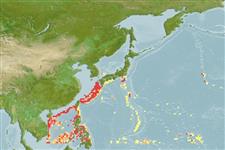Common names from other countries
Élasmobranches (requins et raies) (sharks and rays) >
Carcharhiniformes (Ground sharks) >
Pentanchidae (Deepwater catsharks)
Etymology: Apristurus: a-, Latin privative, i.e., without; pristis, from pristes (Gr.), sawyer (but here meaning saw); oura (Gr.), tail, referring to absence of saw-toothed crest of enlarged dermal denticles along upper edge of caudal fin as found in the closely related Pristiurus (=Galeus). (See ETYFish); herklotsi: In honor of British botanist-ornithologist Geoffrey Alton Craig Herklots (1902-1986), University of Hong Kong, “with many fond memories of the China Sea and Java”. (See ETYFish).
More on author: Fowler.
Environment: milieu / climate zone / depth range / distribution range
Écologie
marin bathydémersal; profondeur 533 - 864 m (Ref. 39445). Deep-water; 36°N - 8°N
Western Pacific: Japan, the Philippines, East and South China seas, and the Kyushu-Palau Ridge.
Taille / Poids / Âge
Maturity: Lm ? range ? - ? cm
Max length : 48.5 cm TL mâle / non sexé; (Ref. 11146)
Épines dorsales (Total) : 0; Épines anales: 0. Brownish without conspicuous markings (Ref. 244).
A poorly known deep-water bottom shark (Ref. 11146). Oviparous (Ref. 50449).
Life cycle and mating behavior
Maturities | Reproduction | Spawnings | Egg(s) | Fecundities | Larves
Oviparous, paired eggs are laid. Embryos feed solely on yolk (Ref. 50449).
Compagno, L.J.V., 1984. FAO Species Catalogue. Vol. 4. Sharks of the world. An annotated and illustrated catalogue of shark species known to date. Part 2 - Carcharhiniformes. FAO Fish. Synop. 125(4/2):251-655. Rome: FAO. (Ref. 244)
Statut dans la liste rouge de l'IUCN (Ref. 130435)
CITES (Ref. 128078)
Not Evaluated
Menace pour l'homme
Harmless
Utilisations par l'homme
Pêcheries: intérêt commercial mineur
Outils
Articles particuliers
Télécharger en XML
Sources Internet
Estimates based on models
Preferred temperature (Ref.
115969): 6.3 - 10.6, mean 7.4 (based on 40 cells).
Phylogenetic diversity index (Ref.
82804): PD
50 = 0.5000 [Uniqueness, from 0.5 = low to 2.0 = high].
Bayesian length-weight: a=0.00355 (0.00176 - 0.00714), b=3.09 (2.91 - 3.27), in cm Total Length, based on LWR estimates for this (Sub)family-body shape (Ref.
93245).
Niveau trophique (Ref.
69278): 3.9 ±0.4 se; based on size and trophs of closest relatives
Résilience (Ref.
120179): Très faible, temps minimum de doublement de population supérieur à 14 ans (Fec assumed to be <10).
Fishing Vulnerability (Ref.
59153): Moderate vulnerability (39 of 100).
